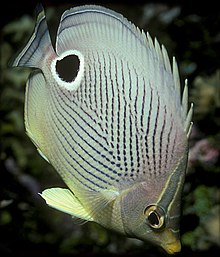
Back Automimetismo Spanish خودتقلیدی Persian חקיינות עצמית HE Keautomimikan Malay Automimikry Swedish 自擬態 Chinese

In zoology, automimicry, Browerian mimicry, or intraspecific mimicry, is a form of mimicry in which the same species of animal is imitated. There are two different forms.
In one form, first described by Lincoln Brower in 1967, weakly-defended members of a species with warning coloration are parasitic on more strongly-defended members of their species, mimicking them to provide the negative reinforcement learning required for warning signals to function. The mechanism, analogous to Batesian mimicry, is found in insects such as the monarch butterfly.
In another form, first noted by Edward B. Poulton in 1890, a less vulnerable part of an animal's body resembles a more vulnerable part, for example with deceptive eyespots or a false head that deflects attacks away from the real head, providing an immediate selective advantage. The mechanism is found in both vertebrates such as fishes and snakes, and insects such as hairstreak butterflies.
Automimicry has sometimes been put to military use. The A-10 Thunderbolt (Warthog) was often painted with a false canopy on its underside, imitating itself, while the armoured recovery vehicle variant of the Churchill tank had a dummy gun, imitating an armed variant of the same tank.
© MMXXIII Rich X Search. We shall prevail. All rights reserved. Rich X Search